The Kirksville Tornado
Tornadoes cannot currently be measured by the speed of their winds. This is partly because it's difficult to fabricate a measuring device than can withstand the severe wind and debris damage caused by tornadoes, and party because it's even more difficult to get those wind instruments in the path of a tornado. Therefore, the strength of a tornado is instead measured by surveying the damage and comparing it to known damage at a controlled speed. For instance, if tests reveal that it takes winds of 136 mph to strip the bark off a tree, and the damage from an actual tornado shows trees with their bark stripped, the tornado could be classified EF3
This damage scale, known as the Enhanced Fujita scale, was instituted February 1, 2007. It replaced the original Fujita scale, but basically remains the same with one main change. The Enhanced Fujita scale takes into consideration differences in building quality and the strength of structures that deteriorate over time.
Here is a simplified Enhanced Fujita scale:
EF0 - Winds 65-85 mph - Light Damage - some damage to roof & siding surfaces, branches broken, trees pushed over.
EF1 - Winds 86-110 mph - Moderate Damage - roofs severely damaged, mobile homes overturned or severely damaged, windows & doors broken.
EF2 - Winds 111-135 mph - Considerable Damage - roofs destroyed, mobile homes completely destroyed, foundations shifted, large trees uprooted or snapped, light objects become missiles, cars lifted.
EF3 - Winds 136-165 mph - Severe Damage - entire stories of well-built homes destroyed, severe damage to large buildings, trees debarked, trains overturned, heavy cars lifted.
EF4 - Winds 166-200 mph - Devastating Damage - well-built houses completely leveled, objects become missiles, cars thrown.
EF5 - Winds 200 mph+ - Total Destruction - large neighborhoods destroyed, landmarks rendered unrecognizable.
The last F5 tornado was May 3, 1999 in Moore, a suburb of Oklahoma City. The first EF5 tornado occurred eight years later, in Greensburg, Kansas on May 4, 2007 and destroyed the entire town. The most recent occurred in Parkersburg, Iowa on May 28, 2008, and destroyed half the town.
When the National Weather Service conducted its initial damage survey of the Kirksville tornado, they rated it an EF2. They have since re-rated it an EF3. On May 14th, we conducted our own damage survey. This is what we found:
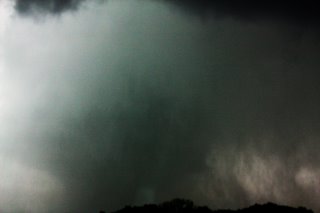
At around 6pm local time, the tornado touched down several miles west of Kirksville, MO. The tornado continued on a ENE path, crossing Rt. 6 west of Kirksville just a few hundred yards in front of us, strengthening, and forming a wedge-shape. The tornado crossed several large fields, changed its direction to due East and began destroying structures on the western edge of Kirksville, near the intersection of State Hwy. B & Brewington Ave. The damage in this area was rated at EF1.
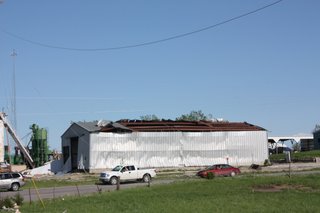
The tornado then crossed Rt. 63 on the Northern edge of Kirksville, killing two people, flipping cars at a dealership, and causing significant damage to structures in the area. At this point, the tornado resembled a cone shape, and the damage was rated at EF2. After crossing Rt. 63, the tornado kept its cone shape and began heading ESE. The tornado crossed several fields and tree lines along State Hwy. P, causing tree damage and moderate damage to structures before crossing St. Hwy. P just South of Clearwater Way.
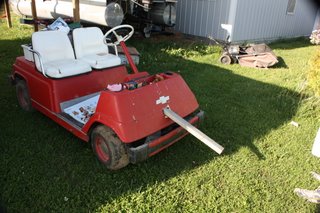
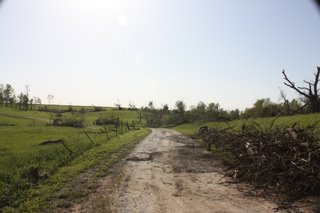
The tornado strengthened again, and was now carrying debris large distances, causing severe damage to trees and structures as it approached Dairy Way. The tornado was now snapping and debarking trees, snapping power and telephone poles, flipping sheds, throwing missiles, and completely destroying small structures such as silos and small barns. The tornado continued to strengthen and bear ESE, killing livestock along Steer Creek Way.
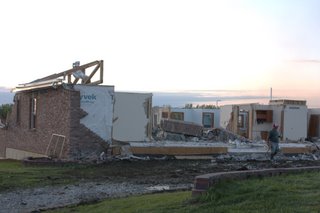
The tornado then reached its strongest point, causing very strong EF3 damage as it completely removed the upper levels of a new brick house, destroying and tossing farm equipment, snapping whole trees in half, killing livestock, generating large missiles, and crossing ESE over Steer Creek Way.
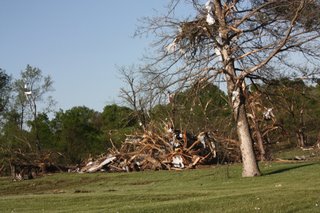
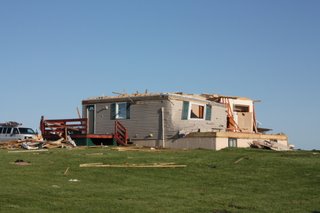
It completely destroyed another house, completely removing its roof and carrying it for almost a mile, snapped large pines and hardwood trees, stripping bark, removing large branches, sending 2x4 missiles through automobiles and exterior walls of houses, removing entire structures and carrying them aloft for more than 1/2 mile, throwing large farm equipment, ripping heavy welding, dragging large trucks several hundred yards, and pulling posts from the ground.
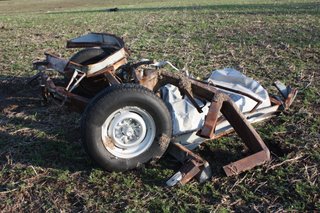
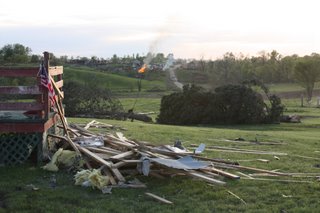
A possible satellite tornado or extended suction vortex may have formed North of the main funnel and lifted a barn roof, carrying it before throwing it into a tree. The tornado, now South of Steer Creek Way, began to weaken, but still causing considerable damage to trees and smaller structures, and carrying large debris large distances and over 100 ft. in height. It crossed a field just West of State Hwy. 11, still in a cone shape, breaking trees, flattening road signs, snapping power poles, and pulling fences from the ground and carrying them, and missed a farmhouse between Steer Creek Way and J Point RL. After crossing State Hwy. 11 just North of us, the tornado "roped-out" and dissipated after a few minutes. A larger, more powerful tornado then formed East of there, but struck a less-populated area.
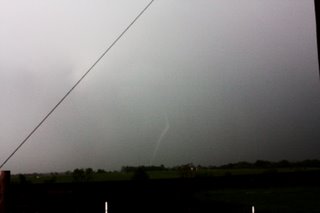
The results of our damage survey were astonishing - we had twice been less than 200 yards from a very strong, very large EF3 tornado. The Kirksville tornado had the power to snap thick trees, twist steel, carry large objects through the air for miles, and topple brick walls. Had the tornado passed a mile or so to the South, through downtown Kirksville, the results would have been devastating. Through detailed damage surveys like ours, and by comparing our results with steadily improving radar & satellite data, scientists and engineers will be able to better understand the forces at work in tornadoes, and make warnings earlier, structures stronger, and lives easier to protect...
This damage scale, known as the Enhanced Fujita scale, was instituted February 1, 2007. It replaced the original Fujita scale, but basically remains the same with one main change. The Enhanced Fujita scale takes into consideration differences in building quality and the strength of structures that deteriorate over time.
Here is a simplified Enhanced Fujita scale:
EF0 - Winds 65-85 mph - Light Damage - some damage to roof & siding surfaces, branches broken, trees pushed over.
EF1 - Winds 86-110 mph - Moderate Damage - roofs severely damaged, mobile homes overturned or severely damaged, windows & doors broken.
EF2 - Winds 111-135 mph - Considerable Damage - roofs destroyed, mobile homes completely destroyed, foundations shifted, large trees uprooted or snapped, light objects become missiles, cars lifted.
EF3 - Winds 136-165 mph - Severe Damage - entire stories of well-built homes destroyed, severe damage to large buildings, trees debarked, trains overturned, heavy cars lifted.
EF4 - Winds 166-200 mph - Devastating Damage - well-built houses completely leveled, objects become missiles, cars thrown.
EF5 - Winds 200 mph+ - Total Destruction - large neighborhoods destroyed, landmarks rendered unrecognizable.
The last F5 tornado was May 3, 1999 in Moore, a suburb of Oklahoma City. The first EF5 tornado occurred eight years later, in Greensburg, Kansas on May 4, 2007 and destroyed the entire town. The most recent occurred in Parkersburg, Iowa on May 28, 2008, and destroyed half the town.
When the National Weather Service conducted its initial damage survey of the Kirksville tornado, they rated it an EF2. They have since re-rated it an EF3. On May 14th, we conducted our own damage survey. This is what we found:
At around 6pm local time, the tornado touched down several miles west of Kirksville, MO. The tornado continued on a ENE path, crossing Rt. 6 west of Kirksville just a few hundred yards in front of us, strengthening, and forming a wedge-shape. The tornado crossed several large fields, changed its direction to due East and began destroying structures on the western edge of Kirksville, near the intersection of State Hwy. B & Brewington Ave. The damage in this area was rated at EF1.
The tornado then crossed Rt. 63 on the Northern edge of Kirksville, killing two people, flipping cars at a dealership, and causing significant damage to structures in the area. At this point, the tornado resembled a cone shape, and the damage was rated at EF2. After crossing Rt. 63, the tornado kept its cone shape and began heading ESE. The tornado crossed several fields and tree lines along State Hwy. P, causing tree damage and moderate damage to structures before crossing St. Hwy. P just South of Clearwater Way.
The tornado strengthened again, and was now carrying debris large distances, causing severe damage to trees and structures as it approached Dairy Way. The tornado was now snapping and debarking trees, snapping power and telephone poles, flipping sheds, throwing missiles, and completely destroying small structures such as silos and small barns. The tornado continued to strengthen and bear ESE, killing livestock along Steer Creek Way.
The tornado then reached its strongest point, causing very strong EF3 damage as it completely removed the upper levels of a new brick house, destroying and tossing farm equipment, snapping whole trees in half, killing livestock, generating large missiles, and crossing ESE over Steer Creek Way.
It completely destroyed another house, completely removing its roof and carrying it for almost a mile, snapped large pines and hardwood trees, stripping bark, removing large branches, sending 2x4 missiles through automobiles and exterior walls of houses, removing entire structures and carrying them aloft for more than 1/2 mile, throwing large farm equipment, ripping heavy welding, dragging large trucks several hundred yards, and pulling posts from the ground.
A possible satellite tornado or extended suction vortex may have formed North of the main funnel and lifted a barn roof, carrying it before throwing it into a tree. The tornado, now South of Steer Creek Way, began to weaken, but still causing considerable damage to trees and smaller structures, and carrying large debris large distances and over 100 ft. in height. It crossed a field just West of State Hwy. 11, still in a cone shape, breaking trees, flattening road signs, snapping power poles, and pulling fences from the ground and carrying them, and missed a farmhouse between Steer Creek Way and J Point RL. After crossing State Hwy. 11 just North of us, the tornado "roped-out" and dissipated after a few minutes. A larger, more powerful tornado then formed East of there, but struck a less-populated area.
The results of our damage survey were astonishing - we had twice been less than 200 yards from a very strong, very large EF3 tornado. The Kirksville tornado had the power to snap thick trees, twist steel, carry large objects through the air for miles, and topple brick walls. Had the tornado passed a mile or so to the South, through downtown Kirksville, the results would have been devastating. Through detailed damage surveys like ours, and by comparing our results with steadily improving radar & satellite data, scientists and engineers will be able to better understand the forces at work in tornadoes, and make warnings earlier, structures stronger, and lives easier to protect...
 RSS
RSS


1 Comments:
Hey Junior, you're look'n mighty svelte.
Post a Comment
<< Home